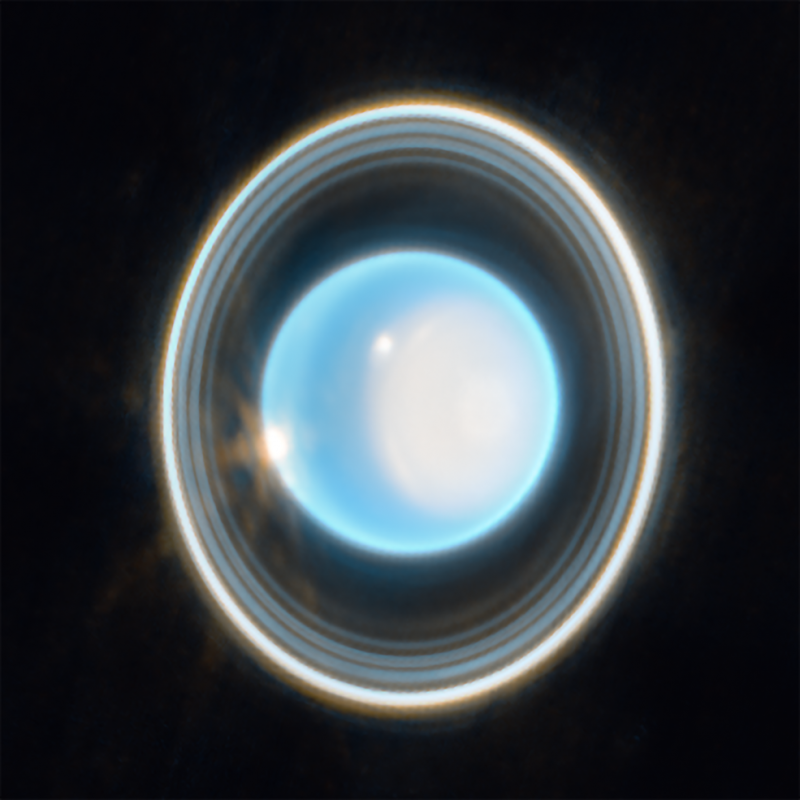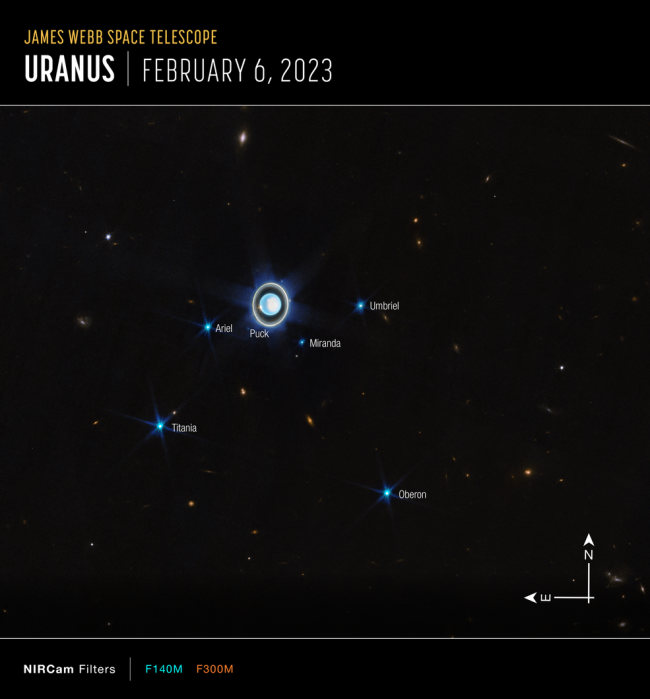
New Uranus image from Webb
The new image of Uranus from the Webb space telescope makes the 7th planet look as if it’s sparkling in the sunlight. And yet Uranus is located some 1.8 billion miles (2.9 billion km) from our sun, in contrast to Earth’s average distance of 93 million miles (150 million km). This image of Uranus isn’t what you’d see by sweeping past in a spacecraft, and looking with your eye alone. It’s an infrared or heat image, acquired by the telescope’s Near-Infrared Camera (NIRCam). It highlights bright features in the planet’s atmosphere. And you can clearly see Uranus’ rings, which are faint to the human eye. Plus, the bright white feature on the right is the north polar cap of Uranus.
Only two other telescopes have ever observed the faint dusty rings of Uranus. The Voyager 2 spacecraft first saw them when it flew past the planet in 1986. And the Keck Observatory used advanced adaptive optics to image the rings starting in 2004.
But even Voyager 2’s close look at Uranus only showed a featureless surface. Webb’s infrared vision lets us see a more dynamic atmosphere.
Last chance to get a moon phase calendar! Only a few left. On sale now.
A closer look at Uranus’s atmosphere
The large, whitish area on the right side of Uranus is the planet’s north polar cap. Webb’s new image shows a subtle brightening at this polar cap’s center.
And if the polar cap looks strange to you, it should. It’s because Uranus tilts nearly sideways with respect to the plane of its orbit around the sun. That is, its axial tilt is about 97 degrees. And that’s a great contrast to the other planets in our solar system. Mercury, for example, rotates so that its north pole is almost straight up. Meanwhile, Earth rotates with its north pole tilted 23.5 degrees from upright. Uranus rotates on its side, so its polar caps are on its side.
And the unusual rotation of Uranus – its strange sideways tilt – causes extreme seasons.
Each season on Uranus lasts the equivalent of 21 Earth years. The planet’s poles have years of constant sunlight followed by years of total darkness. At the moment, it’s late spring for Uranus’ north pole.
A bright cloud sits at the edge of the polar cap. Plus, an even brighter cloud lies near the planet’s limb. These clouds are common features of Uranus in infrared, and scientists believe they are connected to stormy activity.
Rings and moons
Eleven of Uranus’ 13 known rings appear in this new image. But because they are so bright in Webb’s infrared light, some appear to run together. Nine of the rings are part of the main ring system, with two of the rings being the fainter, dusty rings.
Uranus has 27 moons that we know of. In the wide-field image below, we can see six of its larger moons, all with names from characters in Shakespeare’s plays. Webb only peered at Uranus and its moons for 12 minutes with just two filters. Therefore, there’s still plenty more that the telescope can reveal about the 7th planet from the sun.

Bottom line: NASA released a new image of Uranus, highlighting its stunning rings, dynamic atmosphere and bright moons.











